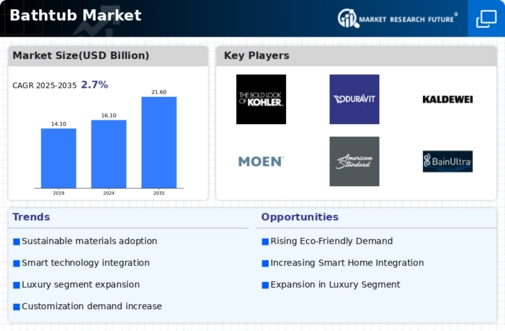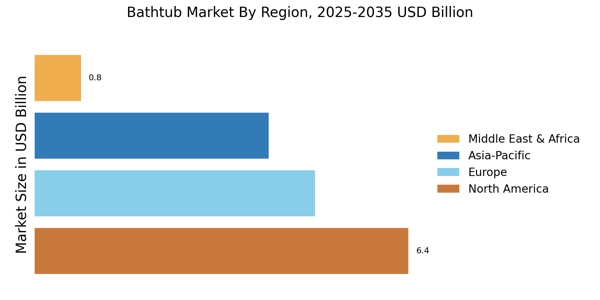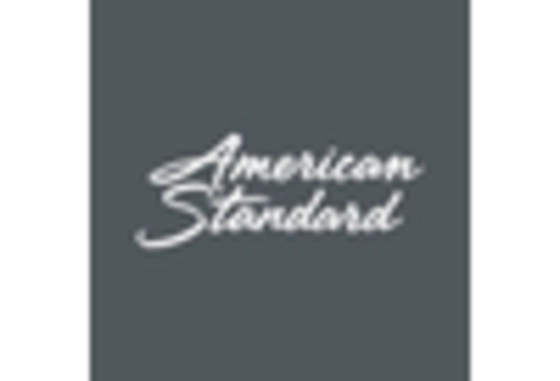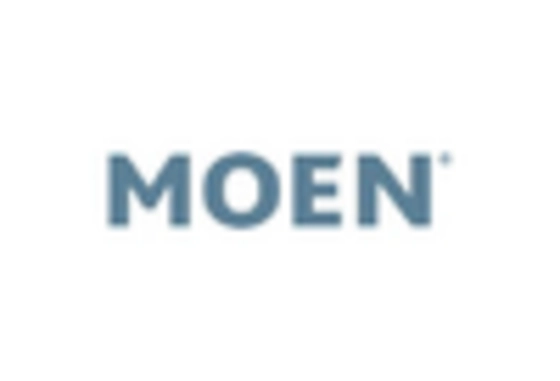The Bathtub Market is currently characterized by a dynamic competitive landscape, driven by factors such as increasing consumer demand for luxury bathroom fixtures, a growing emphasis on wellness and relaxation, and the rising trend of home renovations. Major players like Kohler (US), Moen (US), and TOTO (JP) are strategically positioned to leverage these trends through innovation and product diversification. Kohler (US) focuses on integrating smart technology into its products, enhancing user experience and convenience. Meanwhile, Moen (US) emphasizes sustainability in its manufacturing processes, appealing to environmentally conscious consumers. TOTO (JP) continues to lead in the high-end segment with its advanced toilet-bathtub combinations, showcasing a commitment to both luxury and functionality. Collectively, these strategies contribute to a competitive environment that prioritizes innovation and consumer-centric solutions.
In terms of business tactics, companies are increasingly localizing manufacturing to reduce lead times and enhance supply chain efficiency. This approach not only mitigates risks associated with The Bathtub Market demands. The Bathtub Market appears moderately fragmented, with several key players holding substantial market shares while also facing competition from emerging brands. The collective influence of these established companies shapes market dynamics, as they continuously adapt to consumer preferences and technological advancements.
In August 2025, Kohler (US) announced the launch of its new line of smart bathtubs, which feature integrated voice control and personalized settings for temperature and water flow. This strategic move underscores Kohler's commitment to innovation and positions the company as a leader in the smart home segment. By enhancing user experience through technology, Kohler aims to capture a larger share of the luxury market, appealing to tech-savvy consumers seeking convenience and customization in their bathing experiences.
In September 2025, Moen (US) unveiled its latest initiative to incorporate recycled materials into its bathtub production, aligning with its sustainability goals. This action not only addresses growing consumer demand for eco-friendly products but also enhances Moen's brand image as a responsible manufacturer. By prioritizing sustainability, Moen is likely to attract environmentally conscious consumers, thereby strengthening its market position in an increasingly competitive landscape.
In July 2025, TOTO (JP) expanded its product line to include bathtubs designed specifically for small spaces, catering to urban dwellers with limited bathroom sizes. This strategic expansion reflects TOTO's adaptability to changing consumer needs and its focus on maximizing functionality without compromising on style. By addressing the unique challenges faced by urban consumers, TOTO is poised to enhance its market presence and appeal to a broader audience.
As of October 2025, the Bathtub Market is witnessing significant trends such as digitalization, sustainability, and the integration of artificial intelligence in product design. Strategic alliances among key players are increasingly shaping the competitive landscape, fostering innovation and collaboration. Looking ahead, it is anticipated that competitive differentiation will evolve, with a shift from price-based competition to a focus on innovation, technology integration, and supply chain reliability. Companies that successfully navigate these trends are likely to secure a competitive edge in the market.


















Leave a Comment